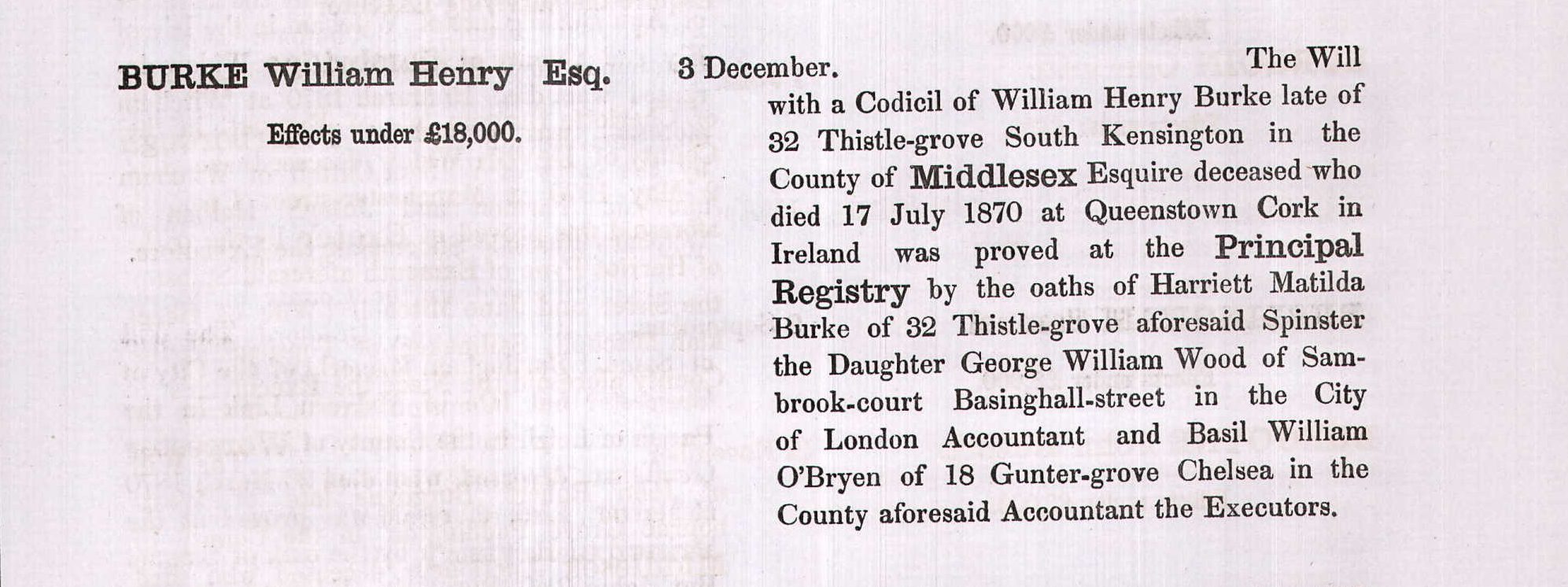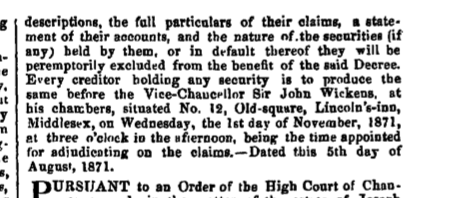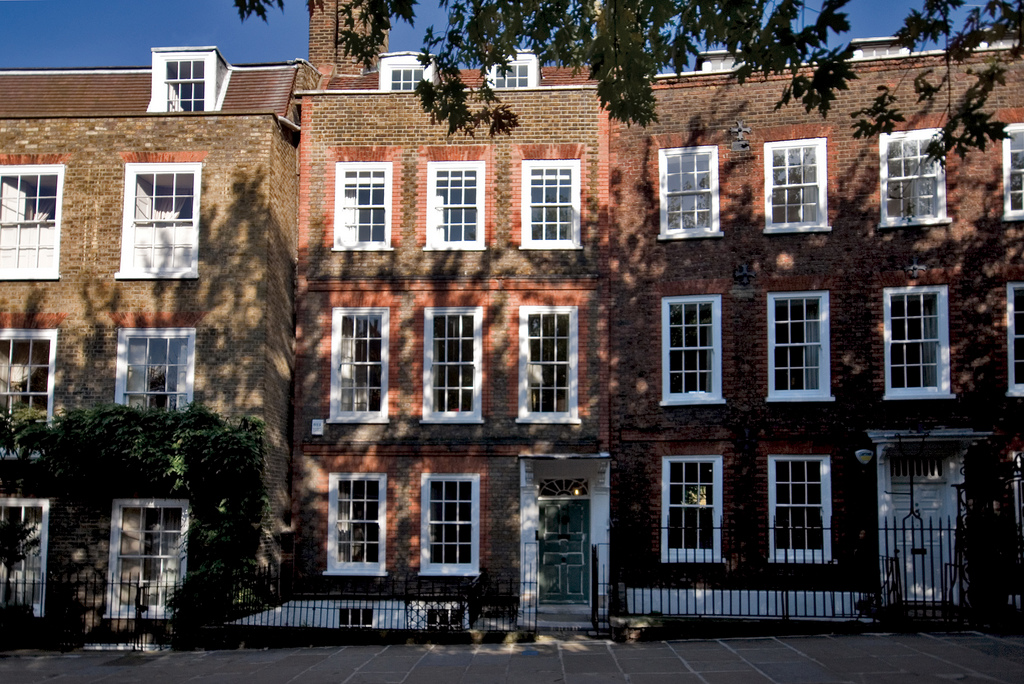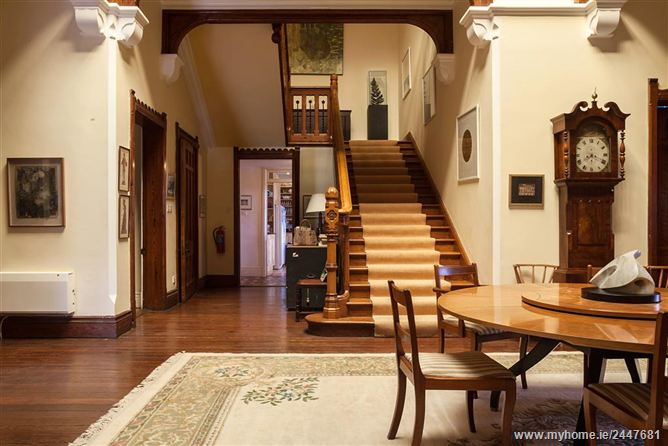THIS IS THE LAST WILL AND TESTAMENT of me John Roche O’Bryen Esquire of Thistle Grove Brompton in the County of Middlesex Doctor of Medicine I appoint my dear wife Celia Mary O’Bryen and the Reverend Henry Hewett O’Bryen D.D. my oldest son to be Executrix and Executors and Trustees of this my Will and Guardians of my infant children during their respective minorities And I direct that my children be educated in the one Holy Catholic Church of which Pius IX is now Pope. I bequeath to my said dear wife all the wines liquors and other consumable effects which shall at my decease be in or about my dwelling house I also bequeath to my said wife the sum of one hundred pounds for her immediate occasion to be paid to her as soon as conveniently may be after my decease I devise the freehold copyhold and leasehold estates to which I shall be entitled at my decease with their appurtenants unto and to the use of my said trustees their heirs executors administrators and assigns according to the nature thereof respectively upon trust when and as my said trustees in order to effectuate any of the purposes of my Will or with a view to the advantage of my estate for the more convenient division thereof among the persons entitled thereto shall in their discretion find it necessary or expedient so to do to sell my said estates or any part thereof together or in parcels by public auction or private contract or to raise money by mortgaging in fee or for years or by charging my said estates or any part thereof and to do all acts requisite for effecting or facilitating any sale mortgage or charge pursuant to this trust I bequeath the residue of my Personal Estate and effects of every kind to which I shall be entitled at my decease unto the said Celia Mary O’Bryen and the Reverend Henry Hewett O’Bryen upon trust subject as herein after mentioned to convert into money get in and receive so much thereof as shall not consist of ready money or of such investments in stocks funds or securities (whether of the description contemplated by the trust for investment herein after contained or not) as my said trustees shall think it desirable to continue And I direct my said trustees to receive the money to arise from my said residuary personal estates and stand possessed thereof together with the stocks funds and securities to be continued as last aforesaid upon the trusts herein after declared concerning the same And as to the monies to arise from the execution of the trusts herein before contained concerning my real and residuary personal estate and not presently applicable to the purposes of my Will I direct my said trustees to invest the same in their names in or upon any of the securities herein after mentioned And I authorize them to vary and transpose at their discretion as well the stocks funds and securities whereon such investment shall be made as any stocks funds or securities which shall at my decease compose part of my personal estate for any other stocks funds or securities of the description contemplated by the preceding direction And I direct my said trustees to stand seized and possessed of my residuary real and personal estate upon the trusts herein after expressed and declared concerning the same that is to say upon trust to permit my said wife to occupy and enjoy at 28 Thistle Grove my residence aforesaid and to have the use of the furniture and other effects in and about the same including the horse and carriage during her life provided she shall so long remain my widow And upon trust to pay the net income arising from the residue of my said real and personal estate to my said dear wife Celia Mary for her life for the maintenance of herself and children and their education which I request may be of the best character in her power In the event of my said wife Celia Mary marrying again after my decease she will have the interest of her own fortune which is already settled upon her And I direct my trustees to stand possessed of the income of my residuary estate during the remainder of the life of my said wife upon trust for the equal benefit of all my children by my said wife And upon trust from and after my decease to set apart out of my residuary estate the sum of one thousand pounds or stocks or shares forming part of my residuary estate of that value at the market price of the day and to pay or transfer the same to the trustees for the time being of a certain Indenture of Settlement bearing date the thirteenth day of May one thousand eight hundred and seventy made between me of the first part my daughter Corine Margaret O’Bryen of the second part and Mrs Mary Celia O’Bryen and Miss Harriet Matilda Burke of 32 Thistle Grove aforesaid of the third part to be held by such trustees upon such and the same trusts as are declared in and by the said Indenture of the trust estate thereby settled And upon trust after the decease of my said wife Celia Mary to set apart out of my residuary estate the further sum of three thousand pounds or stocks and shares forming part of my residuary estate of that value at the market price of the day to be held by them upon trusts herein after expressed and declared for the benefit of my daughter Evelyn and her issue and to set apart in like manner the sum of two thousand pounds for each of my other children by my said wife Celia Mary living at my death And I direct that the income to arise from each said sum of three thousand pounds and the said sums of two thousand pounds and the investments thereof shall be applied to the benefit of my children respectively until they shall respectively attain the age of twenty five years when the corpus shall be paid to sons and shall be settled upon daughters in manner following that is to say Upon trust to pay the income thereof respectively to such daughter for her sole and separate use free from the control of her husbands and so that such daughters shall not have power to dispose of the income in the way of anticipation And upon trust after the decease of my said daughter in trust for all or such one or more of the child and children and remoter issue of my said daughter such remoter issue being born during the life time of my same daughter at such ages or times or age or time in such shares if more than one upon such conditions and in such manner as my same daughter shall by any deed or deeds with or without power of revocation shall appoint And in default of such appointment and so far as any such appointment shall not extend in trust for all the children of my said daughter who being a son or sons shall attain the age of twenty four years or being a daughter or daughters shall attain that age or marry under that age in equal shares and if there shall be but one such child then the whole to be in trust for such one child And subject to the payment of the several last mentioned sums be and shall stand possessed of my residuary real and personal estate in trust to pay or set apart in manner aforesaid and to transfer to the trustees of the said Indenture of Settlement of the thirteenth day of May one thousand eight hundred and seventy and to stand possessed of the ultimate residue of my estate in trust for such child or children of mine by my said wife Celia Mary as she shall by Will or deed appoint at her discretion the sons when they shall attain the age of twenty five years the daughters when they shall attain that age or marry under that age with the consent (if marrying after my death) of her or their respective guardian or guardians and if more than one in equal shares Provided always and I declare that if any child of mine for whom provision is made by this my Will shall die in my life time leaving issue in existence at my death and who being male attain the age of twenty one years or being female attain that age or marry under that age of each such child of mine so dying shall take by substitution as tenants in common in equal shares per stirpes if more than one (and so that no issue remoter than a child of such deceased child shall take except in case of the death in my life time of his her or their own parent and in the place of such parent) the provision which such child of mine would have taken under the trust in that behalf herein before declared had he or she survived but Provided always and I hereby declare that it shall be lawful for the said trustees or trustee for the time being after the death or future marriage of my said wife or during her widowhood with her consent in writing (and so that the present power may be resorted to for the purpose of making an addition to any of the respective legacies herein before bequeathed to each of my sons attaining the age of twenty five years and to each of my daughters attaining that age or marrying under that age with such consent as aforesaid and so augmenting the provision then immediately available for any such son or daughter of mine respectively) to raise any part or parts not exceeding in the whole one half of the then expectant share or presumptive share of any child under the trusts herein before declared and to apply the same for his or her advancement or benefit as the said trustees or trustee shall think fit And I hereby declare that the said trustees or trustee for the time being shall after the death or future marriage of my said wife apply the whole or such part as they or he shall think fit of the interest dividends and income of the share to which any child shall for the time being be entitled in expectancy under the trusts herein before declared for or towards his or her maintenance or education and may either themselves or himself apply the same or may pay the same to the guardian or guardians of such child for the purpose aforesaid without seeing to the application thereof and shall during such suspense of absolute vesting as aforesaid accumulate all the residue (if any) of the same interest dividends and income in the way of compound interest by investing the same and the resulting income thereof in or upon any such stocks funds shares or securities as are herein after mentioned for the benefit of the person or persons who under the trusts herein contained shall become entitled to the principal fund from which the same respectively shall have proceeded and may resort to the accumulations of any preceding year or years and apply the same for or towards the maintenance or education of the child for the time being presumptively entitled to the same in the same manner as such accumulations might have been applied had they been interest dividends or income arising from the original trust funds in the year in which they shall be so applied Provided always and I hereby declare that it shall be lawful for my trustees for the time being to defer and postpone the sale reversion and collection of the whole or any part or parts of my said real and personal estate respectively so long as to such trustees or trustee shall in their or his uncontrolled discretion deem proper but my real estate shall for the purpose of transmission be impressed with the quality of personalty from the time of my death And I empower the said trustees or trustee during such interval or postponement to manage and to let upon lease or from year to year my real and leasehold estates and to make out of the income or capital of my real and personal estate any outlay which such trustees or trustee may consider proper for improvements repairs insurance calls or shares premiums or policies or otherwise for the benefit or in respect of my real or personal estate And I declare that the net rents and profits or other income produced from every or any part of my real or personal estate previously to the conversion or collection thereof pursuant to the trusts herein before declared shall be applied in the same manner in all respects as if the same were income proceeding from such investments as are herein after directed or authorized and that the whole of the income produced from my estate (real or personal) in the actual condition or state of investment for the time being whether consisting of property or investments of an authorized or of an unauthorized description and whether of a permanent or a wasting character shall as well during the first year from my death and at all times afterwards be applicable as income under the trusts of this my Will no part thereof being in any event liable to be retained as corpus or capital but no reversion or other property not actually producing income which shall form part of my estate shall under the doctrine of constructive conversion or otherwise be treated as producing income or as entitling any party to the receipt of income Provided always and I further declare that notwithstanding any thing herein before contained any investments taken or made for the purpose of this my Will during the widowhood of my said wife (whether originally or upon a variation or transposition of investments) may with her concurrence and consent (whether she shall at the time be a trustee for the purposes of this my Will or not) be taken or made (if the trustees or trustee for the time being of this my Will shall so think fit and in their his or her discretion) in or upon any Government or real or leasehold securities in the United Kingdom or Bank Stock or the Debenture Guaranteed or Preferred Stock or Shares or the debentures or obligations of any Railway or other Incorporated Company of the United Kingdom Colonial Bonds and Russian (Nicola) Bonds or any other stocks funds shares or securities which the said trustees or trustee shall consider fitting and safe and every investment so taken or made shall be deemed to all intents and purposes an authorized investment Provided always and I declare that the provision hereby made for my said wife shall be accepted by her in satisfaction and bar of the dower and freebeuth to which by the Common Law or by Custom she might be entitled in or out of the freehold copyhold or customary hereditaments of or to which I have been or am or shall be seized or entitled Provided always and I further declare that (unless as to any such sum I shall in writing direct to the contrary) all sums which I shall in my life time advance or give or covenant or agree to advance or give to or with any of my children on his or her marriage or otherwise for his or her advancement or preferment shall be taken in or towards satisfaction of the provision intended to be hereby made for such children (as to a child dying in my life time) for his or her issue taking by way of substitution as aforesaid for such child respectively and shall be brought into hotchpot and accounted for accordingly But so that with respect to any child of mine any such future advancement shall be taken as being primarily in or towards satisfaction of the legacy herein before bequeathed to such child of mine respectively and as to the excess only (if any) of the amount of such advancement above such legacy respectively shall be taken in or towards satisfaction of the share of such child in my residuary estate And with respect to the issue of any child of mine dying in my life time and such future advancement in favour of the parent shall not be accounted for unless the total amount of such advancement shall exceed two thousand pounds and then shall only be accounted for to the extent of the excess of such advancement above such sum of two thousand pounds And I declare that if any question shall arise as to the amount to be accounted for the same shall be determined by the trustees or trustee for the time being of this my Will (other than the child the value of whose advancement shall be in question if such child shall happen to be a trustee of this my Will) according to their his or her discretion and such determination shall be final And I declare that if the trustees hereby appointed or either of them shall die in my life time or if they or either of them or any future trustee or trustees of this my Will shall die or desire to retire from or refuse or become incapable to act in the trusts of this my Will before the trust shall be fully performed then and in every such case it shall be lawful for my said wife during her life and after her decease for the continuing trustees or trustee for the time being of this my Will or if there shall be no continuing trustee then for the retiring or refusing trustees or trustee or the executors or administrators of the last acting trustee to appoint any other person or persons to be a trustee or trustees in the place of the trustee or trustees so dying or desiring to retire or refusing or becoming incapable to act as aforesaid with liberty upon any such appointment to increase or diminish the original number of trustees and upon every such appointment the trust premises shall be so conveyed and transferred that the same may become vested in the new trustee or trustees either jointly with the continuing trustee or trustees or solely as the case may require and every such new trustee (as well before as after the trust premises shall have become vested in him) shall have all the powers and authorities of the trustee in whose place he shall be substituted I devise and bequeath all estates vested in me as a trustee or mortgagee unto the said Celia Mary O’Bryen and the Reverend Henry Hewett O’Bryen their heirs executors and administrators subject to the trusts and equities affecting the same respectively but so that the money secured by any mortgage shall form part of my personal estate In witness whereof I the said John Roche O’Bryen the testator have to this my last Will and Testament contained in this and the nine preceding sheets of paper set my hand this sixteenth day of May in the year of our Lord one thousand eight hundred and seventy – John R. O’Bryen M.D. – Signed by the said John Roche O’Bryen the testator as and for his last Will and Testament in the presence of us (present at the same time) who at his request in his presence and in the presence of each other have hereunto subscribed our names as witnesses – William Henry Burke 32 Thistle Grove, Brompton – Chas Jas Richards Clerk to Jas Warner 61 Chancery Lane & 9 Livermere Road, Dalston
The Grant of Probate for John Roche O’Bryen’s Will shows assets valued at under £14,000.
This transcription of John Roche O’Bryen’s Will is reproduced from the original manuscript copy retained by the Probate Office Sub Registry in York .


















